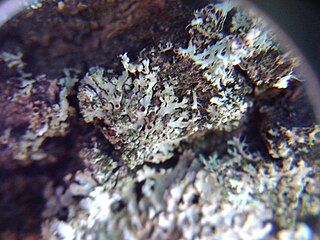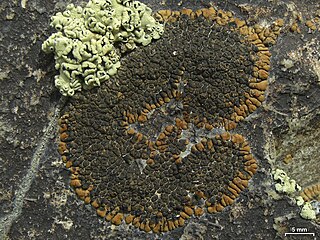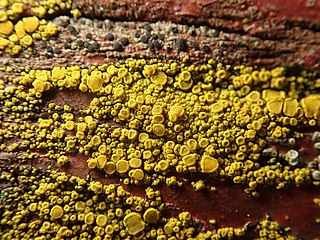Scutula is a genus of lichenicolous fungi in the family Ramalinaceae.

The Physciaceae are a family of mostly lichen-forming fungi belonging to the class Lecanoromycetes in the division Ascomycota. A 2016 estimate placed 19 genera and 601 species in the family.
The Adelococcaceae are a family of fungi in the order Verrucariales. Species are mostly found in north temperate regions, and are biotrophic or necrotrophic on lichens. The family was proposed by mycologist Dagmar Triebel in 1993.

Lichenochora is a genus of fungi in the family Phyllachoraceae. It has 44 species. All species in the genus are lichenicolous, meaning they grow parasitically on lichens. The genus was circumscribed by Josef Hafellner in 1989, with Lichenochora thallina assigned as the type species.

Stigmidium is a genus of lichenicolous (lichen-eating) fungi in the family Mycosphaerellaceae. The genus was circumscribed by Italian botanist Vittore Benedetto Antonio Trevisan de Saint-Léon in 1860, with Stigmidium schaereri assigned as the type species.

Sphaerellothecium is a genus of fungi in the family Phyllachoraceae. All of the species in the genus are lichenicolous, meaning they grow parasitically on lichens.
Merismatium is a genus of lichenicolous (lichen-dwelling) fungi of uncertain familial placement in the order Verrucariales. The genus was circumscribed in 1898 by Friedrich Wilhelm Zopf.

Candelariella is a genus of bright yellow, ocher, or greenish yellow crustose or squamulose lichens in the family Candelariaceae. Members of the genus are commonly called eggyolk lichens, goldspeck lichens, or yolk lichens. The genus was circumscribed in 1894 by Swiss lichenologist Johannes Müller Argoviensis, with Candelariella vitellina assigned as the type species.

Phacopsis is a genus of lichenicolous (lichen-dwelling) fungi. They are parasites of members of the large lichen family Parmeliaceae, of which they are also a member. Originally proposed by Edmond Tulasne in 1852 to contain 3 species, Phacopsis now contains 10 species, although historically, 33 taxa have been described in the genus. Many of the species are poorly known, some of them having been documented only from the type specimen.

Polycoccum is a genus of lichenicolous fungi in the family Polycoccaceae. It has about 60 species.
Endococcus hafellneri is a species of lichenicolous (lichen-eating) fungus in the family Verrucariaceae. It is found in North Asia and the Russian Far East, Estonia, and Japan, where it grows on the lobes of the lichens Flavocetraria cucullata and Cetraria islandica.
Opegrapha verseghyklarae is a little-known species of lichenicolous (lichen-eating) fungus in the family Opegraphaceae. It is found in the Russian Far East, where it grows on the thalli and apothecia of the crustose lichen Ochrolechia pallescens.
Stereocaulon glareosum is a species of snow lichen belonging to the family Stereocaulaceae.
Phacopsis thallicola is a species of lichenicolous (lichen-dwelling) fungus in the family Parmeliaceae. It was first formally described as a new species in 1852 by Italian botanist Abramo Bartolommeo Massalongo, as Lecidea thallicola. The type specimen, collected from the province of Treviso in Italy, was growing on the foliose lichen Parmelia caperata. Dagmar Triebel and Gerhard Walter Rambold transferred the taxon to the genus Phacopsis in 1988. The known generic hosts of Phacopsis thallicola are all in the Parmeliaceae: Parmotrema, Cetrelia, Flavopunctelia, and Hypotrachyna.
Pyrenidium is a genus of lichenicolous (lichen-dwelling) fungi. It is the only genus in the family Pyrenidiaceae. It has 13 species.
Scutula stereocaulorum is a species of lichenicolous fungus in the family Ramalinaceae.
Candelariella lichenicola is a rare species of lichenicolous (lichen-dwelling) fungus in the family Candelariaceae. This species was first found in Sonora, Mexico, and is characterised by its distinct spore shape and chemical composition. It is typically found growing on the lichen species Candelina submexicana, and while not widespread, it contributes to the ecological diversity of the regions it inhabits.
Protothelenella is a genus of fungi in the family Protothelenellaceae. It contains 11 species, some of which form lichens. Protothelenella species have a crustose thallus with spherical to pear-shaped, dark brown to blackish perithecia. Microscopic characteristics of the genus include bitunicate asci with an amyloid tholus, and ascospores that are colourless and contain multiple internal partitions. Some species grow on acidic substrates including rocks, soil, bryophytes, plant detritus or rotten wood. Other species are lichenicolous (lichen-dwelling), growing on species of Solorina, Peltigera, Pseudocyphellaria, or Cladonia.

Coniocarpon is a genus of lichen-forming fungi in the family Arthoniaceae. It has eight species of corticolous (bark-dwelling) lichens. This genus is distinct for its crystalline orange, red, and purple quinoid pigments in the ascomata that turn purple in potassium hydroxide solution, its colourless, transversely septate ascospores with large apical cells, and its rounded to lirellate ascomata.

Polycauliona coralloides, the coral firedot lichen, is a species of small fruticose (bushy), saxicolous (rock-dwelling) lichen in the family Teloschistaceae. First formally described in 1866, it was later shuffled to a few different genera in its taxonomic history before ending up in Polycauliona, a genus resurrected from taxonomic obscurity in the molecular phylogenetics era. The lichen occurs on seaside rocks in the intertidal spray zone of California and northwestern Mexico. The species is readily recognized due to its distinctive coral-like form–its thallus grows as a tangle of orange, filamentous branches.








